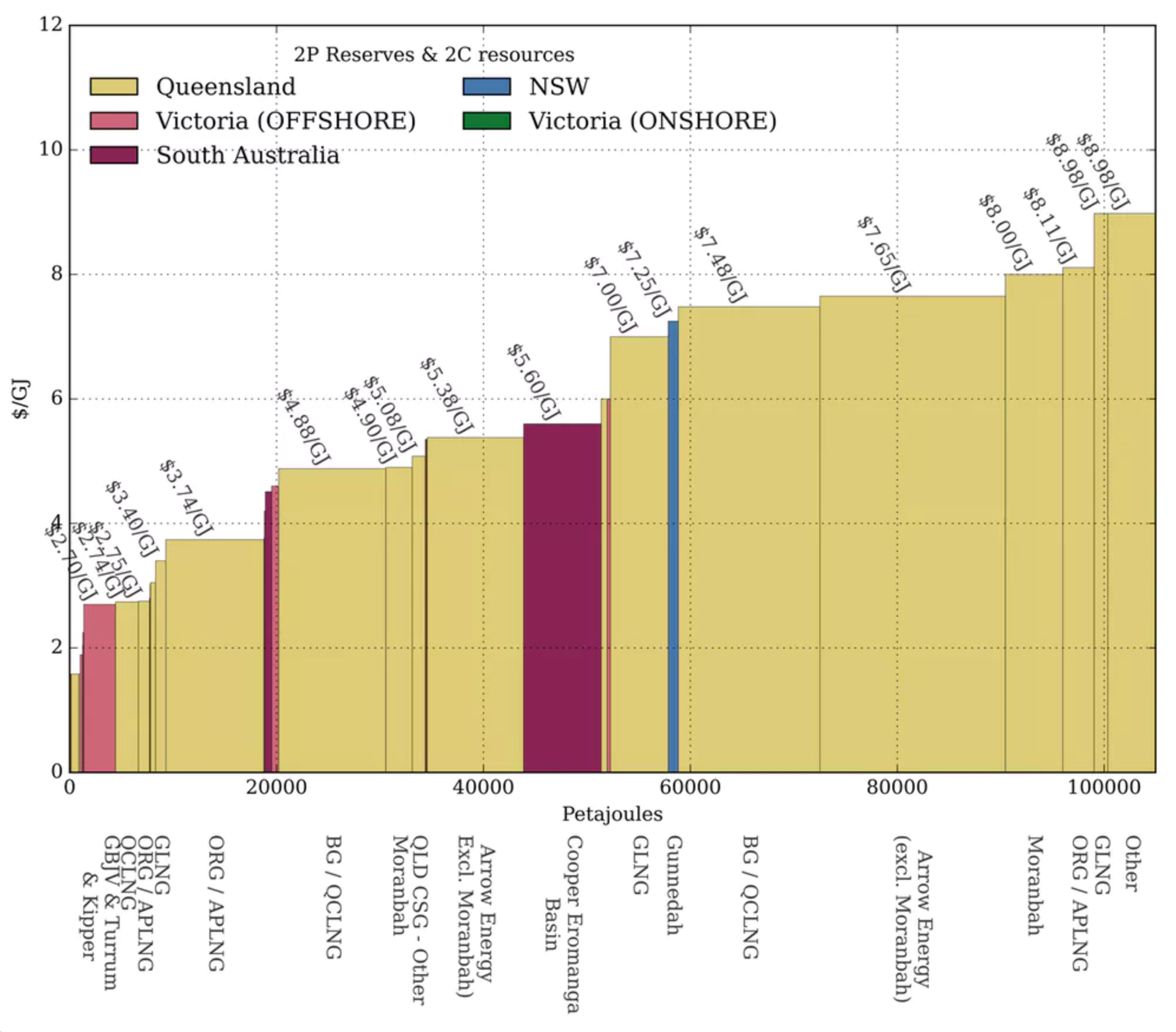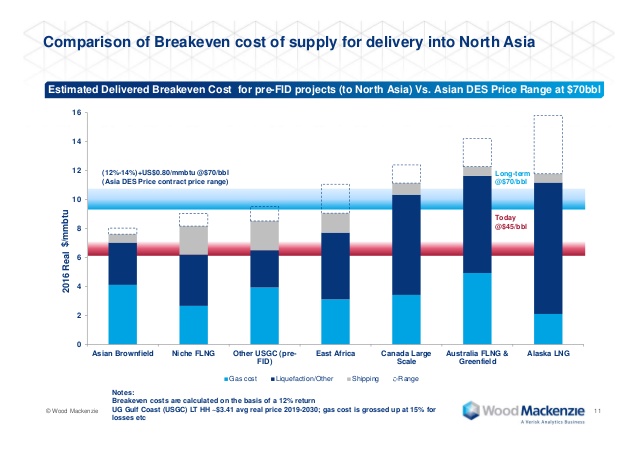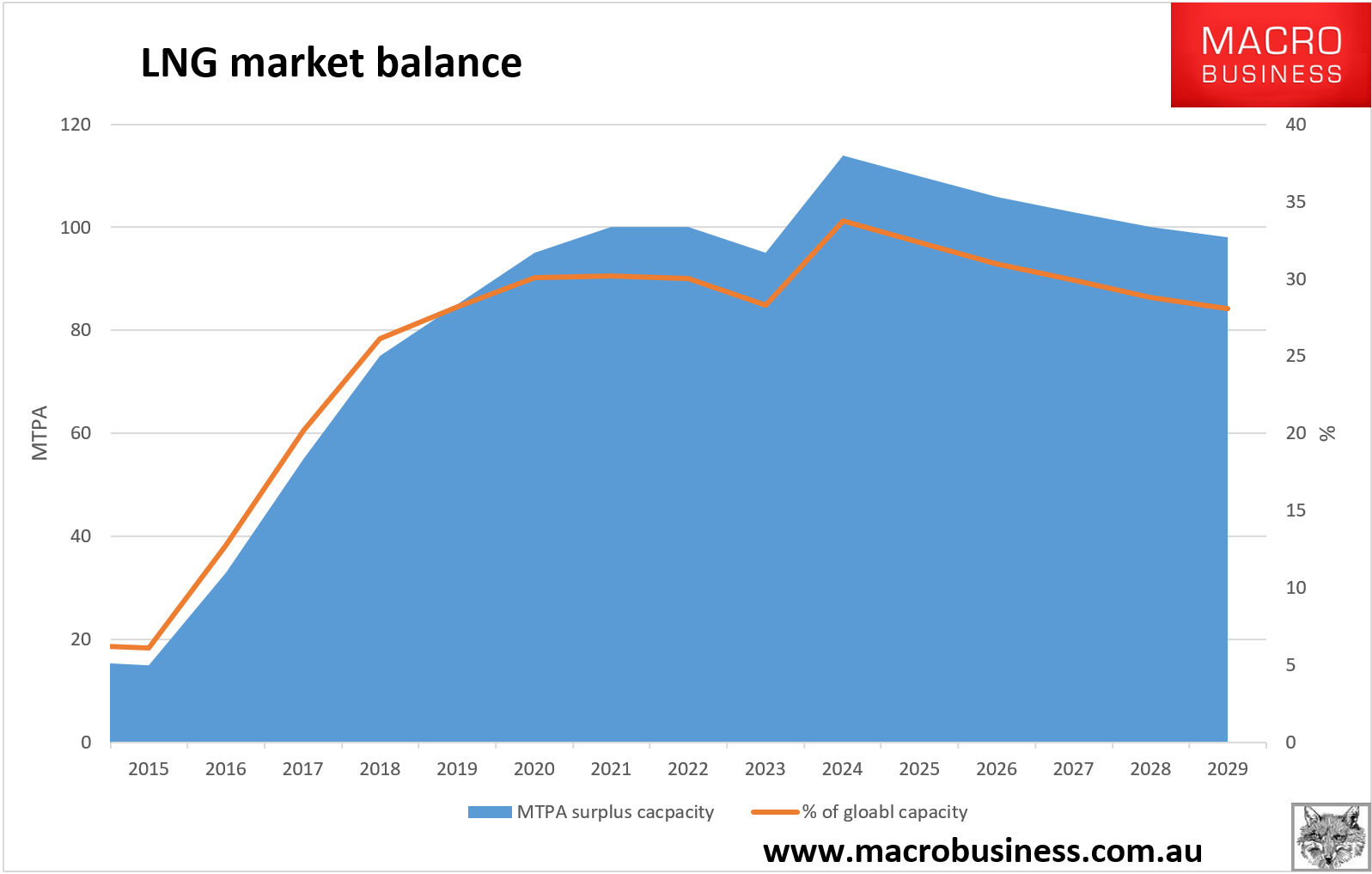Today from the AFR:
International chemical industry investors have warned the gas supply deal does not address the soaring prices that are putting tens of thousands of jobs at risk and are calling for a national energy policy that would help open up onshore gas in Victoria and NSW.
Senior executives at ChemChina, owner of basic plastics manufacturer Qenos, and US giant Dow Chemical say jobs and investment to keep plants in operation are being threatened by the squeeze in east coast gas. They want a policy that prioritises energy supply to domestic industry and onshore drilling restrictions lifted in the southern states.
Dow Chemical’s Australasian head Louis Vega says that last week’s deal struck by the Prime Minister with Queensland’s LNG exporters to fill the 2018 gas shortfall, which is due to be finalised on Tuesday, still leaves a “huge gap” to be filled between asking prices for gas and what chemical makers can afford to pay.
Versus politicised crud from Australia’s leading media intellect, Paul Kelly, over the weekend:
Gas politics is now engulfing the nation. This week Malcolm Turnbull won with an agreement obtained under threat from the gas companies to avert an east coast supply crisis, but the long-term political war will pit the Prime Minister against Victoria, NSW and the Northern Territory to win a boost in sustained supply.
Two entities have been in the firing line — the gas companies and state governments. Both are critical agents in the price rip-offs that have threatened industry and households. The companies cut their losses this week and sought a peace treaty with Turnbull to be policed by the Australian Competition & Consumer Commission.
This leaves the states naked in the firing line. They have played self-interested politics with energy policy too long and too recklessly. Don’t fall for their absurd propaganda that the problem can be fixed by diversion from gas exports. It cannot. Our situation where the states own energy assets but the federal government has over-arching political carriage and responsibility is set to detonate.
The politics of energy and climate change is inexorably changing. The nation is being taught the most elementary lesson — decisions have consequences, and if you decide to lock up gas reserves, the price to pay will be measured in higher costs, lost industry and lost jobs.
Victoria has opted for unscientific green ideology. NSW has pandered to the anti-gas coalition and its approval process has become a large-scale rort. NSW now imports 95 per cent of its gas. The Northern Territory sits on 200 years’ worth of gas resources. Victoria has banned onshore conventional and unconventional gas extraction.
…The ACCC’s report this week is stark: it means industry and consumers have been exploited by a dysfunctional market and charged prices far above competitive benchmarks.
Turnbull has a second potential ally in the Commonwealth Grants Commission. Its position paper this month raises the prospect that those states that decide to develop and raise royalties from coal-seam gas should not be penalised in GST redistribution (which means states that refuse to exploit this opportunity would be losers).
…The politics of energy is being incrementally recast. The resistance remains strong yet the forces driving realignment should score some successes. The consequences arising from affordability and reliability are too great.
This week virtually every industry lobby stood behind Turnbull’s agreement with the LNG companies.
The gas saga in Australia has been extraordinary and testifies to the success of green power. It was apparent a decade ago that gas was the logical answer to the market gap left by retreating investment in coal. Yet the green movement, having demonised coal, was highly successful in campaigning against gas development. It benefited from the monumental stupidity and arrogance of the gas companies. They deserve no sympathy from anyone.
At the heart of the politics is the broad alliance between green power and farmers, extending into the heartland of the Nationals and penetrating the Labor and Liberal parties. The campaign against gas development has been manic but also devoid of any assessment of the costs.
The line that “green power” is to blame for the gas crisis is so shockingly inaccurate that in the normal course of events it would result in Mr Kelly being fired.
As I’ve said many times, I support further supply side development of gas resources in Australia. Victoria has very few proven resources so is a moot question. But NSW and QLD have big reserves that are currently tied up in the gas cartel and these should be released. However, even rudimentary analysis shows that doing so will not resolve high local prices. They’re too expensive to extract. From the AEMO:

All of the cheap gas is trapped within the gas cartel.
Moreover, that is a very different question to describing the roots of the gas crisis. On that front, there are three responsible entities, the gas companies themselves, successive federal governments and, believe it or not, the property bubble.
On the companies, the truth is they blew an enormous LNG bubble. There is NO DOUBT that they mis-allocated huge amounts of capital on Curtis Island. The break-even gas prices needed for the plants to make sense are a bad joke in retrospect:

Curtis Island plants needed $12-14Gj gas prices to make sense. It’s currently $8Gj and there is no prospect of it rising long term because of the enormous glut that the same LNG firms have created in Asia:

And with oil-linked prices likely to fall over the long term as global EV sales rocket, this will probably get worse not better.
You need needn’t take my word for any of this. The gas companies themselves have acknowledged it in their own accounts, writing down the value of the Curtis Island investments over and over by many billions of dollars. They are, in any rational terms, virtually worthless.
Except on one front. By ripping all of the cheap gas out of Australia and shipping it offshore to joyful Asian households and business, they have created a local shortage of cheap gas that they can now exploit mercilessly.
The second guilty party in all of this is the federal government. Both sides of politics are to blame. The Rudd and Gillard Governments did not foresee the cheap reserves shortage and allowed the Curtis Island development to proceed. It did not have the power to stop it given we have no national gas management regime, but it did not even try. That is where the Coalition is to blame. In the period of gas project approvals where something might have been done, the Gillard Government was a weak minority affair thanks to Tony Abbott running Kevin Rudd out of office over the resource super profits tax. A chastened Labor was never going to pick a fight with another mining giant. Moreover, we come full circle at this point when we note that the gas cartel lied point blank about its own reserves to the government of the day.
Finally, it should be noted that this was the post-GFC environment in which all parties in Australian government were desperate to see the mitigation of Australia’s near-fatal offshore borrowing habit that had almost killed the nation in the GFC. At the very time the gas approvals were going ahead and projects launching, the European debt crisis was driving an external credit crunch for Australian banks. The $350bn LNG boom has manna from Heaven in protecting the bubble from imploding and nobody was going to question it.
Paul Kelly should try reading his own paper, at The Australian on gas:
As Santos worked toward approving its company-transforming Gladstone LNG project at the start of this decade, managing director David Knox made the sensible statement that he would approve one LNG train, capable of exporting the equivalent of half the east coast’s gas demand, rather than two because the venture did not yet have enough gas for the second.
“You’ve got to be absolutely confident when you sanction trains that you’ve got the full gas supply to meet your contractual obligations that you’ve signed out with the buyers,” Mr Knox told investors in August 2010 when asked why the plan was to sanction just one train first up.
“In order to do it (approve the second train) we need to have absolute confidence ourselves that we’ve got all the molecules in order to fill that second train.”
But in the months ahead, things changed. In January, 2011, the Peter Coates-chaired Santos board approved a $US16 billion plan to go ahead with two LNG trains from the beginning….as a result of the decision and a series of other factors, GLNG last quarter had to buy more than half the gas it exported from other parties.
…In hindsight, assumptions that gave Santos confidence it could find the gas to support two LNG trains, and which were gradually revealed to investors as the project progressed, look more like leaps of faith.
…When GLNG was approved as a two-train project, Mr Knox assuredly answered questions about gas reserves.
“We have plenty of gas,” he told investors. “We have the reserves we require, which is why we’ve not been participating in acquisitions in Queensland of late — we have the reserves, we’re very confident of that.”
But even then, and unbeknown to investors, Santos was planning more domestic gas purchases, from a domestic market where it had wrongly expected prices to stay low. This was revealed in August 2012, after the GLNG budget rose by $US2.5bn to $US18.5bn because, Santos said, of extra drilling and compression requirements.
“At the time of FID (final investment decision), there was a reasonable expectation during the early years that gas would be available in the market at the right price,” Mr Knox said. “However, large volume, long-term east coast gas supply and prices have tightened over the last 18 months, making third-party gas a relatively less attractive gas supply. This is what led to our announcement (that capital spending would increase).” For commercial reasons, Santos had not revealed the volumes of third-party gas needed to feed the second train.
Presentation slides reveal that by then, even with the $US2.5bn of extra spending, third-party purchases had grown from 140 terajoules a day, at FID, to 240 terajoules a day, or 20 per cent of east coast domestic demand.
Santos figured the gas it was taking out of east coast markets would be filled by accelerated production from the Cooper Basin (fuelled by the GLNG supply contract revenue), gas from the Narrabri coal-seam gas project in NSW and helped by the production of shale gas.
Unfortunately, shale drilling did not return hoped-for results, an oil price slump in late 2014 heavily restricted more Cooper Basin drilling and a community backlash, along with regulatory hurdles, stymied Narrabri.
Even before oil prices slumped, Santos revealed its call on domestic gas would be greater than flagged. In a June 2014 presentation slides to an analysts tour of the GLNG facility were told that third party gas would provide between 410 to 570 terajoules of gas per day, or the equivalent of up to half of total east coast domestic demand, even though it was planning to drill 200 to 300 domestic wells a year.
As a result, GLNG, had drilled 769 coal-seam gas wells as of November last year (and presumably connected fewer). This is about a quarter less than the 1000 it had planned to drill by the end of 2015.
Santos and GLNG stuffed up. They got caught up in the LNG bubble and lied to themselves as well as the nation. Yet all of these supply side solutions are asking everyone else to wear the fallout. Failing to fix the structure of gas market is an effective bailout for the stupid bastards that blew it up, paid for by everyone but them.
Alan Kohler has a much better grasp of the economics than does a politicised Paul Kelly:
Santos and Origin have lost two-thirds and half of their value, respectively, over the past few years because of over-investment in LNG exports, and need to make sure they don’t let this domestic gas crisis go to waste.
…One of the great myths of this debate, expressed again at this week’s press conferences by way of blaming the states and the Labor Party, is that there is a whole lot of gas “literally under our feet”, locked up by weak and selfish decisions by the Victorian and NSW governments. There’s not.
It’s not at all clear that if the moratoriums on fracking were lifted, productive gas fields would suddenly materialise. And even if some coal seam gas was liberated from under our feet in NSW and Victoria it would likely be prohibitively expensive and/or unviable.
The cheapest and simplest way to solve the gas shortage is to build more solar and wind power.
For example, a Chinese company named Goldwind is planning a huge 500MW wind farm in Victoria, called Stockyard Hill, having bought the project from Origin Energy. I understand Origin has agreed to buy all of the power for $53 per megawatt hour.
Goldwind will make a decent return from that price and Origin will absolutely clean up, getting $80 for the renewable energy certificates and about $100MWh, on current prices, for the power — a profit margin of 70 per cent.
…If more large-scale wind and solar power generation were to be built, like the massive Stockyard Hill operation, both the electricity price and the demand for gas-generated electricity would fall, and with it the gas price.
The proposition that the system must be underpinned by coal-fired baseload power is both false and irrelevant.
AEMO has made it clear that the transition to renewable energy can be handled with renewables, battery storage and demand management, especially demand management, and it’s irrelevant because no more coal-fired power stations are going to be built anyway (unless the government goes completely mad and builds one).
More or less true except on one very important and unfortunate point. As domestic demand for gas falls, the cartel will simply ramp up exports ever more to ensure that the domestic gas shortage becomes permanent. That is, they’ll ration supply even more as demand falls. The problem is not a shortage of gas. It is that a malevolent cartel has taken control of gas supply and it does whatever it has to to ensure Australia does not have enough of it so that it can apply discriminatory pricing.
This is not just bad policy meeting dumb companies. It is also now an Enron-style gouge amid the wreckage. To prevent it, the cheap gas currently being vomited into Asia at huge losses simply has to be kept here:
- gas reservation is not tough enough. It must be deeper and benchmark prices where we want them. Let the companies sort out who takes the losses;
- install use or lose it laws so that reserves must be developed or sold;
- launch a gas national champion to buy cheaply or expropriate said reserves to develop and sell cheaply, or
- nationalise Santos and shut-in one LNG train permanently.
Let me remind you that the gas shortage causing all of this damage is just 5% of Australia’s total export volumes, a pathetic amount.
The gas cartel must be broken or we will all pay the price.

